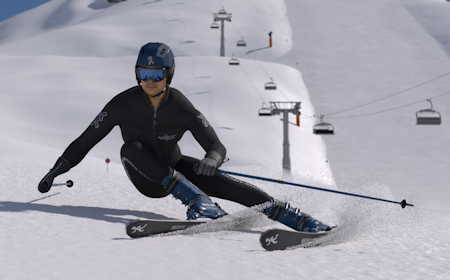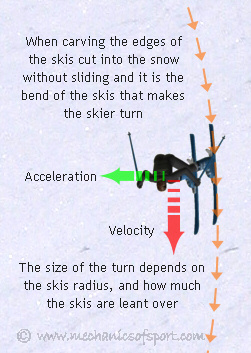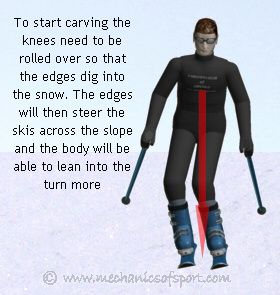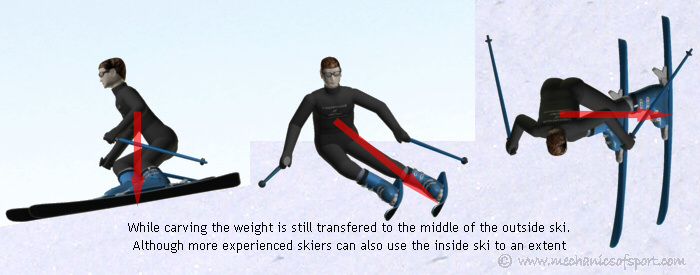Carving

Carving is where the edges cut into the snow so well that the skis do not slide sideways, and travel straight along their length. Because the edges on modern carving skis are curved they cut into the snow in a slight arc, the skis then follow the edges and this takes you around in a turn. This is the most efficient way to turn, as the least amount of snow is being moved as you turn (i.e. wasting the least amount of energy possible), and is also when you can get the largest reaction force from the snow due to the grip of the edges. Ski racers try to carve all the time, as it is the quickest way down the mountain, and conserves as much of their speed as possible.
Bending the Skis
If you look at a ski carefully you will see that it is wider at the front and back than it is in the middle, and that the edges curve inwards and back out again as they go along the ski. Because of this shape when a ski is leant over, it has to bend for the edge to sit in the snow along its length, and the more a ski is leant over, the more the ski has to bend. This can be seen in the moving diagram below.
This means that the skis edge is always along a curved path when it pushes into the snow, and that the more the ski is leant over, the tighter the curve will be.  It is this curved path that carving uses, and the amount of curvature is what decides how big or small a turn will be. The radius of the skis makes a large difference here, as although all modern carving skis will be able to manage many different radii, they will still generally stay closer to the radius that is stated on them. Therefore for smaller turns, slalom skis are good, and for bigger turns, giant slalom or super-g skis are better.
It is this curved path that carving uses, and the amount of curvature is what decides how big or small a turn will be. The radius of the skis makes a large difference here, as although all modern carving skis will be able to manage many different radii, they will still generally stay closer to the radius that is stated on them. Therefore for smaller turns, slalom skis are good, and for bigger turns, giant slalom or super-g skis are better.
Carving has a lot in common with parallel turns, largely because carving turns are parallel turns. But as the skis don't slide sideways there are some differences, mainly with weight movements. With carving we still put more weight on the outside ski as we turn, but we do use the inside ski more than with normal parallel turns. We also don't need to lean forwards to start our turns, as it is the edges that will make us turn now without the skis sliding.
The body position for carving also differs from normal parallel turns in that the shoulders are brought flat to the skis. The direction of travel is now straight along the skis, this is reflected by the shoulders coming flat to this direction and allows you to see where you are going better.
Initiating Carving

To start carving the carve has to be initiated. This is best done as you are pointing straight down the slope, by rolling the knees over so that the ski edges dig into the snow and steer the skis across the slope. The skis need to be put on the edges enough that when they start turning the skis will cut into the snow and not slide. A common mistake made by people learning to carve is that they don't roll the knees over enough, the skis really do need to be lent over to be sure the edges won't slide. Once the edges are dug into the snow and the skis are traveling along their length, the skis will start turning and you will be able to push against them slightly and lean the body to the inside of the turn more. The faster you go while carving the more you will be able to lean, and the harder you can push on the skis.
The Carving Position
When carving properly and leaning into the turn, the body's weight should be transfered to middle of the outside ski. The body is also kept more upright than the legs to enable the edges to be dug into the snow as much as possible, this also makes it easier to switch between turns as the body does not need to be moved so far. The shoulders are brought flat to the direction of the skis, as the direction we are now traveling is straight forwards. Experienced skiers will also use the inside ski when carving to an extent, but this is only when the conditions enable them to really dig the edges on both skis into the snow.

Conditions for Carving
Carving is not always possible, to carve you need to have the right equipment and the right conditions. With most equipment and conditions carving is possible to an extent, but to really carve properly you need the right set up. The snow should be soft enough that the edges can dig into it, but hard enough to hold the sideways forces that you create. In icy conditions is generally when people find it difficult to carve as the edges do not want to cut into the snow so easily. How sharp the edges of your skis are can make a big difference here, as the sharper they are the easier they will dig into the snow.
Good Pistes for Carving
A good piste for carving will generally be quite wide, have good visability down the slope so you can see far ahead and be relatively smooth with not many bumps. What you need to remember with carving is that because you are not wasting much energy in your turns, if you carve properly you will end up going almost as fast as if you went straight down the piste. For this reason it is often found that blue pistes are the best for carving, as they are not too steep. With red and black pistes you often end up going so fast that the force from your speed is too much for the edges to hold without sliding. This either makes you stop carving as you don't have the edge grip, or forces you not to turn very far across the slope ending up in you skiing extremely fast. As you often ski quite fast while carving, a good piste will also not have too many people on it as you need lots of space and don't want to worry too much about having to avoid people.
This section is not yet complete and is taking a while to finish due to the complexity of the graphics to show carving effectively. As soon as the page is completed it will be put on the site, in the meantime please move onto the jumping section.
On to the Jumping section.